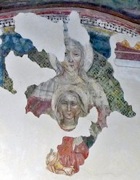Pietro di Giovanni was the son of another artist, Giovanni di Corraduccio Mazzaforte, was last documented in 1437. Three years later, Pietro di Giovanni rented a workshop in his own name, which suggests that his father had died in the interim.
Pietro di Giovanni was the father-in-law of Nicolò di Liberatore, l' Alunno, who trained in his workshop.
In 1458, Ugolino di Gisberto signed a contract for a year-long position as a “garzone” (apprentice) in the workshop of Pietro di Giovanni Mazzaforte and Nicolò di Liberatore, l’Alunno.
Foligno
Virgin and St John the Evangelist (ca. 1463)
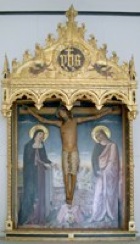
The confraternity took the tabernacle with them in 1569 when they moved to the Oratorio della Misericordia. It was moved to the sacristy of the Duomo in 1904 and is now in the Museo Diocesano.
Assisi
Annunciation (ca. 1439)
This heavily repainted fresco in the spandrels of the aedicule above the entrance of the Oratorio di San Francesco has been attributed to Mazzaforte.
Gonfalone di San Vitale (15th century)
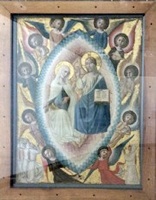
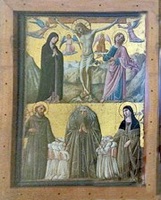
This double-sided standard, which is attributed to Pietro di Giovanni Mazzaforte, came from Oratorio di San Vitale, Assisi.
-
✴On one side, the Virgin commends members of the confraternity (three men knelling at the lower left and a woman kneeling at the lower right) to Christ, who confers his blessing. Both Christ and the Virgin are in a mandorla supported by angels.
-
✴The other side depicts:
-
•the Crucifixion with the Virgin and St John the Evangelist (above); and
-
•the Blessed Vitale surrounded by the kneeling brothers, with SS Francis and Clare. (The Blessed Vitale was a hermit who founded the confraternity in ca. 1362 on Mount Subasio.)
The banner is now in the Pinacoteca Civica, Foligno.
Montefalco
Crucifix with the Virgin and saints (15th century)
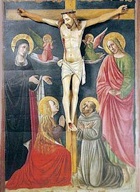
-
✴a polychrome wooden Crucifix; and
-
✴a frescoed backdrop of the Virgin, St John the Evangelist and two angels, with SS Mary Magdalene and Francis kneeling at the foot of the cross.
It was documented in the 19th century in the Observant Franciscan convent of San Fortunato. It almost certainly came from the church, but its original location there is unknown. It is now in the Pinacoteca.
The attribution of the two components of the work is also uncertain:
-
✴The Crucifix has been attributed to a sculptor called Ponziano di Onofrio, on the basis of a signed statue (1484) of St Antony Abbot that Fra. Antonio da Montefalco commissioned for Santa Maria delle Grazie, Massa Martana.
-
✴The fresco is clearly by an artist from Foligno, perhaps Pietro di Giovanni Mazzaforte.
Spello
Frescoes in Cappella Tega (1461)
-
✴the Madonna and Child with St Anne, of which only a fragment (illustrated here) survives;
-
✴St Peter above the gate of Purgatory; and
-
✴St Paul above a depiction of a number of women in Hell.
An inscription under the figure of St Paul gives the date.
Crucifixion (15th century)
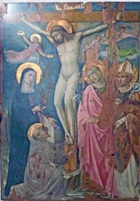
Processional banner (15th century)
This double-sided banner, which came from the Oratorio di Santa Croce, is attributed to Pietro di Giovanni Mazzaforte or his workshop. It belonged to the Compagnia della Croce and the nearby Confraternita della Misericordia, which had merged in 1386.
-
✴The Madonna della Misericordia on the front of the banner is badly damaged.
-
✴The reverse shows the miracle of the apparition of a cross above Spello, which led to the foundation of the Compagnia della Croce.
This foundation miracle occurred (according to tradition) in 1346, when the factions of Spello fought a battle under the nearby Torre dell’ Olmo (demolished in 1457). This conflict ended abruptly when a cross of fire appeared in the sky, and the erstwhile enemies made peace. (In later versions of the legend, the fight occurred at the instigation of a vicious old lady called Gabrina.) In the scene here, figures of Christ and the Virgin flank the Torre dell’ Olmo, looking up at a cross held by angels. Two young men at the foot of the tower (presumably erstwhile combatants) also look up, amazed at the spectacle.
This banner is now in the Pinacoteca Comunale. [It was in restoration in 2009].
St Augustine (15th century)
This fresco, which is in the vault of the Cappella del Beato Andrea of Sant’ Andrea, is attributed to Pietro di Giovanni Mazzaforte or his workshop.
Return to Art in: Assisi Foligno Montefalco Spello.


